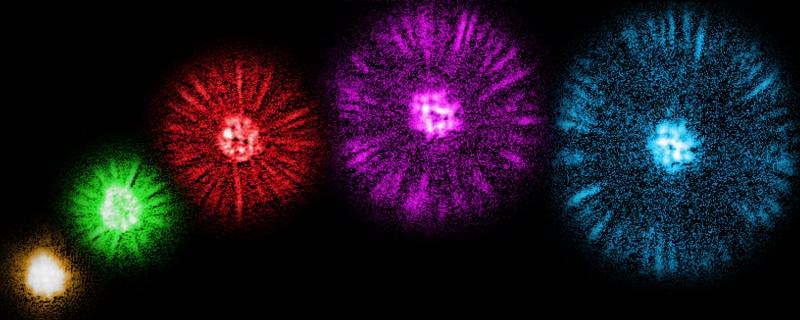Physics in the News
Winter
2018
Special Feature
Physics in the News
3 Recent Developments You Should Know
By:Rachel Kaufman, Editor
Here’s a brief update on some new and exciting developments in the world of physics.
LIGO PIONEERS AWARDED NOBEL PRIZE
The Nobel Prize in Physics in 2017 went to Rainer Weiss of MIT, and Barry Barish and Kip Thorne of Caltech for their leadership making LIGO a reality. The three scientists delivered their Nobel Lectures Dec. 8 in Stockholm.
In some ways the announcement was no surprise, as the excitement around LIGO had been building since the group announced in February 2016 it had observed gravitational waves from colliding black holes. That discovery, which the Royal Swedish Academy said was “a discovery that shook the world,” confirmed a key part of Einstein’s theory of relativity and has the potential to lead to entire new branches of science. Since the initial detection, which occurred in September 2015, LIGO has detected at least four more pairs of black holes colliding.
Not to rest on their laurels, just two weeks after the prize announcement, the LIGO Collaboration announced it had observed two neutron stars colliding.
Read Maya Kinley-Hanlon’s article on page 25 for more details.
TINY QUANTUM FIREWORKS EXPLODE OUT OF LAB
University of Chicago researchers studying Bose-Einstein condensates have discovered a new quantum behavior.
Physics professor Cheng Chin and his team cooled bosons down to nearly absolute zero. When atoms are cooled to extremely low temperatures, they “clump” together and behave as if they were one atom. (It’s weird behavior, and the first Bose-Einstein condensate won its creator a Nobel Prize in 2001.) In Chin’s lab, they created the condensate, then jostled the atoms until they collided and flew out of the condensate. Instead of seeing random ejections, they saw “jets” of atoms flying together, like tiny fireworks. Those jets are composed of thousands of atoms, so “It’s like people forming a consensus and leaving in groups,” Chin said in a press release.
What causes this behavior is not yet well understood but could someday be useful for building new technology.

Read the paper describing the phenomenon in Nature: DOI: 10.1038/nature24272.
STEPHEN HAWKING’S THESIS GOES VIRAL
Dr. Stephen Hawking’s 134-page PhD thesis, “Properties of expanding universes,” has long been the most requested item at the Cambridge library. Last fall, Hawking gave his permission for his thesis to become open access—freely available to download for all.
Just a few hours after the thesis went open access, the demand of 60,000 people trying to get it caused parts of Cambridge’s website to crash.
"It's wonderful to hear how many people have already shown an interest in downloading my thesis,” Hawking told the BBC. “Hopefully they won't be disappointed now that they finally have access to it!"
If you haven’t yet read the work, you can download it, free, in high-resolution from https://cudl.lib.cam.ac.uk/view/MS-PHD-05437/1. //
![]()
Coffee Physics
The physics world was (justifiably) excited by the announcement in October that the 2017 Nobel Prize in Physics went to the architects of the Laser Interferometer Gravitational-Wave Observatory. But careful observers also noticed another stimulating physics award given this fall: the fluid dynamics Ig Nobel, given to college student Jiwon (Jesse) Han for a paper on why coffee sloshes so much in your mug. The Ig Nobel awards are given every year to research that makes “people laugh, then think.”
Han was a high school student when he authored a paper highlighting a number of methods for saving your cuppa from landing on your shirt front—something that should be a benefit for physicists everywhere, since many physicists run on caffeine!
First, he looked into why coffee is so prone to spilling in the first place, using a smartphone's accelerometer to measure the forces in play. This built off 2012 work by H.C. Mayer and R. Kretchetnikov that found that the frequency oscillation of coffee rocking back and forth in an average mug matches a typical person's walking speed. Thus, every step you take holding a coffee mug amplifies the slosh, until—Argh! (Kretchetnikov's research won its own Ig Nobel in 2012 and ended up on a list of "wasteful projects" compiled by Sen. Jeff Flake. Guess you can't please everyone.)
After Han established why coffee spills in the first place, he came up with a number of solutions. Walking backwards is one. Most people's walking frequencies are different, or at least less regular, when they walk backwards (unless they're Ginger Rogers). Of course, walking backwards might not be an ideal solution. As the paper notes, "walking backwards...drastically increases the chances of tripping on a stone or crashing into a passing colleague who may also be walking backwards."
Another solution is to use the "claw grip"—carrying your mug by the top. Han modeled holding a mug by its handle as a simple pendulum. Holding the mug by grasping it from the top turns it into a double pendulum, which suppresses the resonant effect.
Han came up with a number of other, even less practical solutions as well. Dividing the cup into 20 or 30 tiny cylinders changes the resonance of the container, but drinking out of such a cup would be impractical to say the least. A thin layer of foamy soap also dampened the sloshing, but who wants to drink coffee with a layer of soap bubbles? (No word yet on whether foamed milk can save your coffee.)
In the end, the simplest solution may be the one Han gave during his Ig Nobel acceptance speech in September: "For those who do not want to spill their coffee, that's why the lid was invented." //
